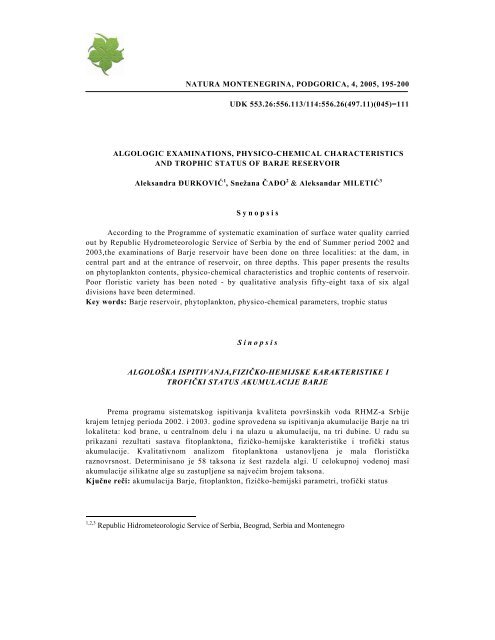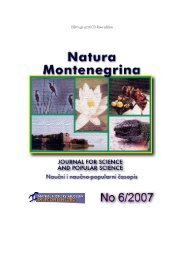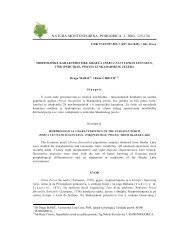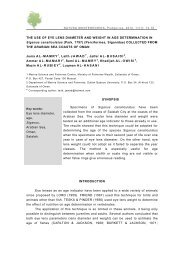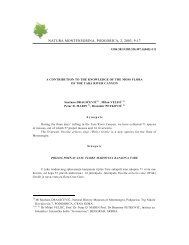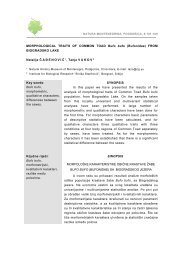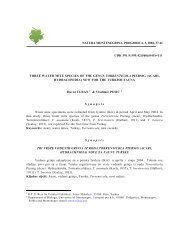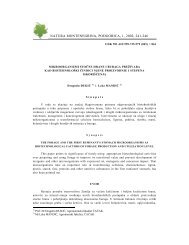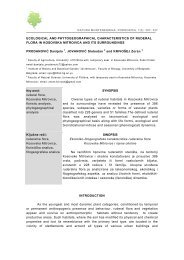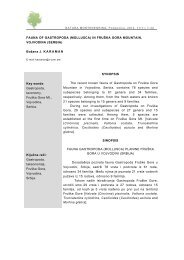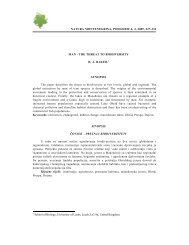Djurkovic_et_al_NM4.pdf
Djurkovic_et_al_NM4.pdf
Djurkovic_et_al_NM4.pdf
Create successful ePaper yourself
Turn your PDF publications into a flip-book with our unique Google optimized e-Paper software.
NATURA MONTENEGRINA, PODGORICA, 4, 2005, 195-200<br />
UDK 553.26:556.113/114:556.26(497.11)(045)=111<br />
ALGOLOGIC EXAMINATIONS, PHYSICO-CHEMICAL CHARACTERISTICS<br />
AND TROPHIC STATUS OF BARJE RESERVOIR<br />
Aleksandra ĐURKOVIĆ 1 , Snežana ČAĐO 2 & Aleksandar MILETIĆ 3<br />
Synopsis<br />
According to the Programme of systematic examination of surface water qu<strong>al</strong>ity carried<br />
out by Republic Hydrom<strong>et</strong>eorologic Service of Serbia by the end of Summer period 2002 and<br />
2003,the examinations of Barje reservoir have been done on three loc<strong>al</strong>ities: at the dam, in<br />
centr<strong>al</strong> part and at the entrance of reservoir, on three depths. This paper presents the results<br />
on phytoplankton contents, physico-chemic<strong>al</strong> characteristics and trophic contents of reservoir.<br />
Poor floristic vari<strong>et</strong>y has been noted - by qu<strong>al</strong>itative an<strong>al</strong>ysis fifty-eight taxa of six <strong>al</strong>g<strong>al</strong><br />
divisions have been d<strong>et</strong>ermined.<br />
Key words: Barje reservoir, phytoplankton, physico-chemic<strong>al</strong> param<strong>et</strong>ers, trophic status<br />
Sinopsis<br />
ALGOLOŠKA ISPITIVANJA,FIZIČKO-HEMIJSKE KARAKTERISTIKE I<br />
TROFIČKI STATUS AKUMULACIJE BARJE<br />
Prema programu sistematskog ispitivanja kv<strong>al</strong>it<strong>et</strong>a površinskih voda RHMZ-a Srbije<br />
krajem l<strong>et</strong>njeg perioda 2002. i 2003. godine sprovedena su ispitivanja akumulacije Barje na tri<br />
lok<strong>al</strong>it<strong>et</strong>a: kod brane, u centr<strong>al</strong>nom delu i na ulazu u akumulaciju, na tri dubine. U radu su<br />
prikazani rezultati sastava fitoplanktona, fizičko-hemijske karakteristike i trofički status<br />
akumulacije. Kv<strong>al</strong>itativnom an<strong>al</strong>izom fitoplanktona ustanovljena je m<strong>al</strong>a floristička<br />
raznovrsnost. D<strong>et</strong>erminisano je 58 taksona iz šest razdela <strong>al</strong>gi. U celokupnoj vodenoj masi<br />
akumulacije silikatne <strong>al</strong>ge su zastupljene sa najvećim brojem taksona.<br />
Kjučne reči: akumulacija Barje, fitoplankton, fizičko-hemijski param<strong>et</strong>ri, trofički status<br />
1,2,3 Republic Hidrom<strong>et</strong>eorologic Service of Serbia, Beograd, Serbia and Montenegro
196<br />
Natura Montenegrina, 4/2005<br />
INTRODUCTION<br />
The reservoir was formed by the V<strong>et</strong>ernica River, 30 km upstream of the town of<br />
Leskovac at the place c<strong>al</strong>led Barje. The first, primary aim was to protect Leskovac from<br />
flooding waters, afterwards as the protection from sediments compiling, for regulation of flow<br />
and ensurance of guaranteed biologic<strong>al</strong> minimum. Today this reservoir is primarily used for<br />
water supply for town of Leskovac and the municip<strong>al</strong>ity of Lebane. Concerning the fact that<br />
the filling was ended in 1995, that year has been taken as a zero point for water qu<strong>al</strong>ity<br />
d<strong>et</strong>ermination. At maximum the reservoir has the volume of 40.6 · 10 6 m 3 , whilst the area is<br />
139 hectares. In the conditions of norm<strong>al</strong> USPOR the volume is 26.2 · 10 6 m 3 with maxim<strong>al</strong><br />
depth of 25 m. The average width is 300 m and the length, depending on filling, varies<br />
b<strong>et</strong>ween 7.1 and 7.5 km.<br />
MATERIAL AND METHODS<br />
Republic Hydrom<strong>et</strong>eorologic Service of Serbia has carried out the physico-chemic<strong>al</strong><br />
and biologic<strong>al</strong> examinations of water qu<strong>al</strong>ity of Barje reservoir, since 1993, under the<br />
Programme of Systematic Surface Water Qu<strong>al</strong>ity Examination. This Programme had<br />
established three loc<strong>al</strong>ities of free water of reservoir, for sample taking: at the dam (A), at the<br />
centr<strong>al</strong> part of the reservoir (B) and at the entrance of the reservoir (C). On each loc<strong>al</strong>ity, the<br />
samples are taken at three depths: 0.5 m under water surface (1), in the midde part of water<br />
coloumn (2) and by the bottom of the reservoir (3).<br />
Physico-chemic<strong>al</strong> and biologic<strong>al</strong> examinations are carried out according to standard<br />
m<strong>et</strong>hodology for sampling and working. Materi<strong>al</strong> for biologic<strong>al</strong> an<strong>al</strong>ysis was collected by<br />
using plankton n<strong>et</strong>, mesh size of 25 µm and hydrobiologic bottle after Ruttner, volume of 4.5<br />
dm 3 . The samples have been fixed to by form<strong>al</strong>dehyde to the fin<strong>al</strong> concentration of 4 %.<br />
Transparency was measured by Secchi disc. The an<strong>al</strong>ysis of physico-chemic<strong>al</strong> param<strong>et</strong>ers was<br />
carried out by using standard an<strong>al</strong>ytic<strong>al</strong> procedures by the m<strong>et</strong>hods of JUS-ISO, EPA.<br />
The phytoplankton qu<strong>al</strong>itative an<strong>al</strong>ysis was carried out in biologic<strong>al</strong> lab of RHMS by<br />
using certain keys for d<strong>et</strong>ermination, for each <strong>al</strong>g<strong>al</strong> group separately. The d<strong>et</strong>ermined taxa<br />
have been grouped in the divisions on the basis of classification system due to which <strong>al</strong>gae are<br />
<strong>al</strong>ligned in ten divisions (B l a ž e n č i ć , J. 1988.). Silicate <strong>al</strong>gae have been d<strong>et</strong>ermined from<br />
the materi<strong>al</strong> made by a standard procedure (P a t r i c k & R e i m e r , 1966.) with the<br />
formation of lasting preparations waxed in canada b<strong>al</strong>sam. Trophic status of reservoir is given<br />
due to OECD reservoir (M a n d a v i l l e , S. M.2000.).<br />
RESULTS AND DISCUSSION<br />
The results of physico-chemic<strong>al</strong> an<strong>al</strong>ysis are given in Tab. 1. Barje reservoir belongs to<br />
dimictic lakes of the medium-continent<strong>al</strong> type that are characterized by two circulation<br />
periods, in Spring and Autumn, whilst there is the revers<strong>al</strong> therm<strong>al</strong> stratification. In the<br />
results of examinations from August 2003 there have been noted the temperature differences<br />
b<strong>et</strong>ween layers of epilimnion and hypolimnion on the loc<strong>al</strong>ities at the dam and in the centr<strong>al</strong><br />
part of the lake, whilst at the entrance due to a sm<strong>al</strong>l depth the water temperature is even from<br />
surface to the bottom. The examinations taken in September 2002 are pointing to the<br />
beginning of the Autumn circulation process. The water transparency in that year was
ĐURKOVIĆ, A. <strong>et</strong> <strong>al</strong>: Algologic Examinations and Trophic Status of Barje Reservoir<br />
relatively low that is characteristic<strong>al</strong> for eutrophic lakes. In 2003 on the loc<strong>al</strong>ity at the dam<br />
the measured transparency had v<strong>al</strong>ues characteristic<strong>al</strong> for mesotrophic lakes. The high pH<br />
v<strong>al</strong>ues (from 7.38 to 8.50) have been noted that is caused by high bioproduction in water. The<br />
soluble oxygen v<strong>al</strong>ues had the highest v<strong>al</strong>ues in surface water layers. The lowest v<strong>al</strong>ues of<br />
that param<strong>et</strong>er have been noted in 2003 at the entrance of the reservoir (8.55 mg/dm 3 ) and<br />
highest (9.6 mg/dm 3 ) at the dam. In surface water layers of the centr<strong>al</strong> part of the reservoir<br />
and of the dam (2002) <strong>al</strong>so in a surface layer, the super saturation has been noted. The BOD<br />
v<strong>al</strong>ues, are <strong>al</strong>so the highest in surface water layers, due to the huge amount of<br />
biodecomposable organic materi<strong>al</strong>s. The COD that refers to contents of organic substances in<br />
water increases by depth. The primary nutrients concentrations are of a certain influence on a<br />
degree of a primary production of water ecosystems. The primary production is firstly<br />
regulated by the amount of available phosphorous (SEPA 1991). According to the<br />
categorization of primary nutrients belonged to fourth (IV) and the fifth (V) class. In 2003<br />
the concentrations of Ntot matched the fifth (V) class, whilst the phosphorous concentrations<br />
in a vertic<strong>al</strong> coloumn were in the second (II) and the third (III) class.<br />
Table 1. Results of physico-chemic<strong>al</strong> water an<strong>al</strong>ysis of Barje reservoir<br />
god. A1 A2 A3 B1 B2 B3 C1 C2 C3<br />
Param<strong>et</strong>er<br />
Depth (m)<br />
2002.<br />
2003.<br />
0.5<br />
0.5<br />
15.0<br />
14.5<br />
30.0<br />
29.0<br />
0.5<br />
0.5<br />
7.0<br />
12.0<br />
15.0<br />
25.0<br />
0.5<br />
0.5<br />
1.0<br />
1.5<br />
1.5<br />
3.5<br />
Water temperature 2002. 22.0 17.2 15.0 22.0 20.0 16.8 22.2 22.2 21.8<br />
( 0 C) 2003. 24.0 11.4 8.3 24.6 19.0 10.0 24.2 24.0 24.0<br />
Transparency (m)<br />
2002.<br />
2003.<br />
2.6<br />
3.5<br />
2.5<br />
2.5<br />
1.0<br />
1.9<br />
pH v<strong>al</strong>ue<br />
2002.<br />
2003.<br />
8.3<br />
8.55<br />
8.1<br />
7.9<br />
7.9<br />
7.6<br />
8.3<br />
7.38<br />
8.0<br />
7.9<br />
8.0<br />
7.8<br />
8.3<br />
8.40<br />
8.2<br />
8.30<br />
8.2<br />
8.08<br />
Dissolved O2 2002. 9.6 3.1 1.8 9.5 4.7 3.5 8.7 8.4 8.6<br />
(mg/dm 3 ) 2003. 8.81 5.26 4.57 8.90 7.02 3.72 8.55 8.32 8.38<br />
% of water<br />
saturation by O2<br />
(% O2)<br />
2002.<br />
2003.<br />
110<br />
99<br />
32<br />
48<br />
18<br />
39<br />
110<br />
108<br />
52<br />
76<br />
38<br />
33<br />
100<br />
103<br />
97<br />
99<br />
98<br />
101<br />
BOD<br />
2002. 1.2 1.2 1.2 8.3 1.5 1.6 1.5 2.1 1.0<br />
(O2 mg/dm 3 ) 2003. 4.81 1.82 1.9 5.2 3.20 1.20 5.10 5.20 4.90<br />
COD<br />
(O2 mg/dm<br />
2002. 1.8 2.4 3.1 1.6 2.5 3.1 1.6 1.8 1.8<br />
3 on<br />
KMnO4) 2003. 5.71 3.86 6.38 3.95 4.28 3.20 4.03 3.92 3.92<br />
N tot<br />
2002. 0.8 0.6 1.1 0.6 0.3 0.8 0.6 0.8 0.5<br />
(N-mg/dm 3 ) 2003. 2.5 1.5 2.6 2.1 1.9 2.5 2.0 1.9 1.6<br />
P tot<br />
2002. 0.025 0.039 0.084 0.026 0.024 0.025 0.060 0.030 0.032<br />
(P-mg/dm 3 ) 2003. 0.008 0.022 0.021 0.008 0.012 0.015 0.012 0.012 0.014<br />
Silicium dioxide 2002. 17.0 19.0 17.0 17.0 19.0 15.0 13.0 15.0 14.0<br />
(SiO2 mg/dm 3 ) 2003. 3.0 12.6 17.7 3.4 8.2 12.5 3.7 3.8 3.9<br />
A relatively sm<strong>al</strong>l vari<strong>et</strong>y has been noted by qu<strong>al</strong>itative an<strong>al</strong>ysis, that does not show<br />
important changes compared to previous examinations (O b u š k o v i ć , L J . 1996; S i m i ć ,<br />
S . 2000.). There have been d<strong>et</strong>ermined 58 taxa from six <strong>al</strong>g<strong>al</strong> divisions: Cyanophyta (5 taxa),<br />
197
198<br />
Natura Montenegrina, 4/2005<br />
Bacillariophyta (28 taxa), Chrysopyta (2 taxa), Pyrrhophyta (3 taxa), Euglenophyta(6 taxa)<br />
and Chlorophyta (2 taxa). The highest number of taxa belong to Bacillariophyta, (48.27 %)<br />
and Chlorophyta (24.13 %), whilst other <strong>al</strong>gae are present with considerably lower number of<br />
taxa, what coincides with the results of previous examinations (O b u š k o v i ć , L J . 1996;<br />
K<strong>al</strong>afitić , V . <strong>et</strong> <strong>al</strong>. 1997; S i m i ć , S . <strong>et</strong> <strong>al</strong>. 2000.). No matter that the rep<strong>et</strong>itive of<br />
fire and green blue <strong>al</strong>gae have been presented with low number of taxa their populations have<br />
had huge number of individu<strong>al</strong>s and therefore have been the dominant constituents of<br />
phytoplankton community. This refers in the first place to species Ceratium hirudinella<br />
which was the dominant species in each period of the examination, whilst the species<br />
Microcystys aeruginosa was dominant in 2002. In 2002 the dominant species were <strong>al</strong>so<br />
Closterium aciculare and Fragilararia crotonensis. The domination of these <strong>al</strong>gae is notable<br />
in surface water layers, at the dam and in the centr<strong>al</strong> point of the lake, whilst at the entrance,<br />
probably due to the beginning of a process of autumn circulation and sm<strong>al</strong>l depth, the density<br />
of their populations in the vertic<strong>al</strong> water coloumn was the same.<br />
In 2003 the dominant species were Ceratium hirudinella and Closterium aciculare<br />
whilst the species Fragilararia crotonensis and Asterionella formosa were subdominant. The<br />
population density of these species was high not only in surface water, but <strong>al</strong>so in deeper<br />
layers. According to OECD classification system, the trophic status of reservoir<br />
(M a n d a v i l l e , S . M . 2000) by the ararage concentrations of tot<strong>al</strong> phosphorous and<br />
chlorophyll a in vertic<strong>al</strong> water coloumn as well as the transparency can be characterized as<br />
eutrophic in 2002, whilst in the 2003 it came to lower mesotrophic degree of trophy what<br />
indicates that this reservoir in a changing stadium of eutrophication. Having in the mind that<br />
this reservoir is relatively young and that the terrain cleansing has been done before the<br />
filling it is necessary to take certain protection measures to prevent the increase in<br />
eutrophication process. Data obtained by monitoring (biomonitoring and phisico−chemic<strong>al</strong><br />
param<strong>et</strong>ers of water) in monthly period should enable water qu<strong>al</strong>ity monitoring not only of<br />
reservoir, but should define <strong>al</strong>so the influence of the V<strong>et</strong>ernica River on the reservoir. The<br />
slowing down of the eutrophication process and reservoir aging can be done by biologic<strong>al</strong><br />
measures by biomanipulation, influencing the production of the main components of aquatic<br />
ecosystem in the frame of biocenosis, its b<strong>al</strong>ance, with elimination of possible production of<br />
the excess of organic substance in system (K<strong>al</strong>afatić, V. <strong>et</strong> <strong>al</strong>.1997.).<br />
CONCLUSION<br />
In August 2002 and September 2003, according to Programme of Systematic<br />
Examination of Surface Water Qu<strong>al</strong>ity carried out by RHMS of Serbia, physico-chemic<strong>al</strong> and<br />
biologic<strong>al</strong> examinations have been carried out on Barje reservoir. Fifthy-eight taxa from six<br />
<strong>al</strong>g<strong>al</strong> divisions have been d<strong>et</strong>ermined. The highest number of taxa belonged to Bacillariophyta<br />
(48.27%) and Chlorophyta (24.13%). The dominant species in the period of examinations<br />
were Ceratium hirudinella, Closterium aciculare, Microcystys aeruginosa and Fragilaria<br />
crotonensis. Trophic status of reservoir can be defined as unstable, because it varied from<br />
mesotrophic to eutrophic, so certain reassures should be taken to protect the reservoir from<br />
intensive eutrophication.
ĐURKOVIĆ, A. <strong>et</strong> <strong>al</strong>: Algologic Examinations and Trophic Status of Barje Reservoir<br />
Table2. Floristic<strong>al</strong> contents of <strong>al</strong>gae in phytoplankton samples of Barje<br />
Cyanophyta<br />
Anabaena constricta Geitler<br />
Anabaena Bory sp.<br />
Aphanizomenon flos-aquae (L.) R<strong>al</strong>fs<br />
Microcystis aeruginosa Kutz.<br />
Chrysophyta<br />
Dinobryon divergens Imhof<br />
Dinobryon stipitatum Ehrb.<br />
Bacillariophyta<br />
Amphora ov<strong>al</strong>is Kützing<br />
Asterionella formosa Hass<strong>al</strong>l<br />
Aulacoseira granulata (Ehrb.) Simonsen<br />
C<strong>al</strong>oneis amphisbaena (Bory) Cl.<br />
Cocconeis pediculus Ehrb.<br />
Cocconeis placentula Ehrb.<br />
Cyclotella meneghiniana Kützing<br />
Cyclotella radiosa Grunow<br />
Cyclotella (Kütz) Breb. sp.<br />
Cymatopleura elliptica Bréb.<br />
Cymatopleura solea (Bréb.) W. Smith<br />
Cymbella Ahardh sp.<br />
Diatoma vulgare Bory<br />
Fragilaria constuens (Ehrb.) Grunow<br />
Fragilaria crotonensis Kitton<br />
Fragilaria ulna (Nitzsch) Lange-Bert<br />
Fragilaria ulna var. acus (Kütz.)<br />
Lange-Bert.<br />
Fragilaria dilatata (Breb.) Lange-Bert.<br />
g/dm 3<br />
25<br />
20<br />
15<br />
10<br />
5<br />
0<br />
14.8<br />
3.43<br />
2.13<br />
12.96<br />
7<br />
9<br />
Gomphonema olivaceum (Hornemann) Bréb.<br />
Gyrosigma acuminatum (Kütz.) Rab.<br />
Navicula cryptoceph<strong>al</strong>a Kützing<br />
Navicula radiosa Kützing<br />
Nitzschia sigmoidea (Ehrb.) Smith<br />
Rhop<strong>al</strong>odia gibba (Ehrb) Müller<br />
Rhoicosphaenia abbreviata (Kütz.) Rab.<br />
Stephanodiscus Ehrb. sp.<br />
Surirella minuta Bréb.<br />
Surirella tenera Gregory<br />
Pyrrhophyta<br />
Ceratium hirundinella (O.F.M.) Bergh<br />
Peridinium cinctum (O.F.M.) Ehrb.<br />
Chlorophyta<br />
Closterim Nitzsch sp.<br />
Closterium acerosum (Ehrb.)<br />
Closterium aciculare T. West<br />
Coelastrum astroideum<br />
Coelastrum microporum Näg.<br />
Eudorina elegans Ehrb.<br />
Pandorina morum Bory<br />
Pediastrum boryanum (Turp.) Menegh<br />
Pediastrum simplex var. simplex Meyen<br />
Scenedesmus acuminatus (Lag.) Chod.<br />
Scenedesmus sempervirens (Chod.)<br />
Staurastrum cha<strong>et</strong>oceros (Schr.) G. M.<br />
Smith<br />
Staurastrum gracile R<strong>al</strong>fs<br />
Volvox globator (L.) Ehrb.<br />
5.2<br />
2.44 2.21<br />
2.1<br />
0.84<br />
14.8<br />
5.26<br />
5<br />
3.81<br />
4.1 4.73<br />
A1 A2 A3 B1 B2 B3 C1 C2 C3<br />
Mesto uzorkovanja<br />
Chlorophill-a 2002 Chlorophill- a 2003<br />
Figure 1. Concentration v<strong>al</strong>ues of chlorophyll-a of Barje reservoir in 2002 and 2003.<br />
199
200<br />
Natura Montenegrina, 4/2005<br />
LITERATURE<br />
A P H A , A W W A , W P C F (1989): Standard M<strong>et</strong>hods for the Examination of Water &<br />
Wastewater, 18 th Edition, American Public He<strong>al</strong>th Association, Washington.<br />
Blaženč i ć , J . (1988): Sistematika <strong>al</strong>gi, "Naučna knjiga", Beograd.<br />
Obušković , L J . (1996): Algološke i saprobiološke odlike akumulacije "Barje". Konferencija<br />
“Zaštita voda 1996”, Zbornik radova. Jugoslovensko društvo za zaštitu voda, Beograd: 85-89.<br />
H i n d á k , F . (1978): Sladkovodné riasy – Slovenské pedagogické nakladatelstvo, Bratislava.<br />
K<strong>al</strong>afatić , V., Martinović -Vitanović V., Cib<strong>al</strong>ić , V . (1997): Rezultati<br />
jednogodišnjeg praćenja kv<strong>al</strong>it<strong>et</strong>a vode akumulacije Barje – biološki aspekt. Konferencija “Zaštita<br />
voda 1997”, Zbornik radova. Jugoslovensko društvo za zaštitu voda, Beograd: 325-332.<br />
Laušević , R . (1995): Prostorna i vremenska dinamika životnih zajednica ekosistema veštačkih<br />
jezera (akumulacija). Biološki fakult<strong>et</strong> Univerzit<strong>et</strong>a u Beogradu, Institut za botaniku i botanička<br />
bašta "Jevremovac".<br />
Simić ,S.,Simić ,V., Ostojić ,A., Ranković ,B.,Ilić G . (2000): Ocena kv<strong>al</strong>it<strong>et</strong>a<br />
vode akumulacije Barje na osnovu bioloških param<strong>et</strong>ara. Konferencija “Zaštita voda 2000”,<br />
Zbornik radova. Jugoslovensko društvo za zaštitu voda, Beograd: 215-220.<br />
M a n d a v i l l e , S . M . (2000): Lymnology-Eutrophication and Chemistry, Carrying Capacities,<br />
Loadings, Benthic Ecology, and Comparative Data, Soil & Water Conservation Soci<strong>et</strong>y of M<strong>et</strong>ro<br />
H<strong>al</strong>ifax, Synopses 1,2,3,13, and 14, 210 p.<br />
P a t r i c h , R . , R e i m e r , C . (1966): The Diatoms of the United States. 1 – Monograph Acad.<br />
Nat. Sci. Philadelphia.<br />
S c h w o e r b e l , J . (1970): M<strong>et</strong>hods of Hydrobiology (Fresh Water Biology), Pergamon Press,<br />
Oxford.<br />
S E P A - S w e d i s h E n v i r o n m e n t a l P r o t e c t i o n A g e n c y (1991): Qu<strong>al</strong>ity Criteria for<br />
Lakes and Watercourses. A System for Classification of Water Chemistry and Sediment and<br />
Organism M<strong>et</strong><strong>al</strong> Concentrations. 32 pp.<br />
Sirenko, L. A., Gavrilenko, Я . M . (1978): Water "Blossoming" and Euthrophication,<br />
Academy of Science of Ukrainian SSR, Hydrobiology Institute, "Naukova dumka".


